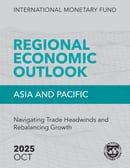At a Glance - China and the IMF
- Current IMF membership: 191 countries
- China joined the Fund in December 27, 1945; Article VIII (December 1, 1996)
- At a Glance—China and the IMF
- Quota: SDR 9,525,9 million
News and Highlights
Letter from Vitor Gaspar to WANG Jun on China Tax Administration Reform, June 2021
June 16, 2021
September 24, 2019
E-Book: Opening Up and Competitive Neutrality: The International Experience and Insights for China
September 23, 2019
wp18244c China s Monetary Policy Communication (中文)
November 6, 2018
China’s Monetary Policy Communication: Frameworks, Impact, and Recommendations
IMF Working Paper, November 16, 2018
November 6, 2018
IMF's Work on China
No results found. Either there was an error with the web service or there is no data returned by the web service.
IMF China Working Papers
2019
China’s Digital Economy: Opportunities and Risks (January 17, 2019)
2018
China’s High Savings: Drivers, Prospects, and Policie s (December 11, 2018)
The Long-Run Trend of Residential Investment in China (December 7, 2018)
China’s Monetary Policy Communication: Frameworks, Impact, and Recommendations (November 16, 2018) - Also Available in Chinese
China’s Rebalancing: Recent Progress, Prospects and Policies (November 12, 2018)
China’s Capacity Reduction Reform and Its Impact on Producer Prices (September 28, 2018)
Inequality in China - Trends, Drivers and Policy Remedies (June 5, 2018)
Intergovernmental Fiscal Reform in China (April 13, 2018)
Credit Booms - Is China Different? (January 4, 2018)
2017
Reassessing the Perimeter of Government Accounts in China (December 8, 2017) – Translated into Chinese for Res. Rep. but not posted on imf.org.
Resolving China's Zombies: Tackling Debt and Raising Productivity (November 27, 2017) – Also Available in Chinese
Assessing China’s Residential Real Estate Market (November 16, 2017)
Real Exchange Rate and External Balance : How Important Are Price Deflators? (March 30, 2017)
Price and Wage Flexibility in Hong Kong SAR (January 20, 2017)
2016
Quantifying the Spillovers from China Rebalancing Using a Multi-Sector Ricardian Trade Model (November 15, 2016)
When China Sneezes Does ASEAN Catch a Cold? (November 10, 2016)
Resolving China’s Corporate Debt Problem (October 14, 2016)
Rebalancing in China—Progress and Prospects (September 6, 2016)
China’s Growing Influence on Asian Financial Markets (August 12, 2016)
Spillovers from China’s Growth Slowdown and Rebalancing to the ASEAN-5 Economies (August 09, 2016)
Chinese Imports : What’s Behind the Slowdown? (May 26, 2016)
China and Asia in Global Trade Slowdown (May 26, 2016)
China's Slowdown and Global Financial Market Volatility: Is World Growth Losing Out? (March 15, 2016)
Private Sector Activity in Hong Kong SAR and the Fed: Transmission Effects through the Currency Board (February 23, 2016)
2015
China’s Labor Market in the “New Normal”, Lam ,Liu , and Schipke (July 13, 2015)
China’s Growth: Can Goldilocks Outgrow Bears? Maliszewski and Zhang (May 27, 2015)
Understanding Residential Real Estate in China, Chivakul, Lam , Liu , Maliszewski , and Schipke (April 28, 2015)
Assessing China’s Corporate Sector Vulnerabilities, Chivakul and Lam (March 30, 2015)
China: How Can Revenue Reforms Contribute to Inclusive and Sustainable Growth? Lam and Wingender (March 24, 2015)
Regional Economic Outlook
October 24, 2025

Navigating Trade Headwinds and Rebalancing Growth
Economies in the Asia-Pacific region have been resilient so far in 2025. Nevertheless, higher US tariffs will likely reduce external demand and eventually weigh on growth. Greater regional integration and structural reforms will be critical for sustainable growth.
Read the Report



